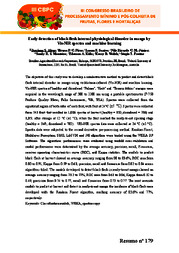Early detection of black flesh internal physiological disorder in mango by Vis-NIR spectra and machine learning.
Early detection of black flesh internal physiological disorder in mango by Vis-NIR spectra and machine learning.
Author(s): ALVES, J. S.; PIRES, B. P. C.; SANTOS, L. F.; MELLO JÚNIOR, N. R. C. de; MONTEIRO, S. R. S.; KIDO, E. A.; WALSH, K. B.; FREITAS, S. T. de
Summary: The objective of this study was to develop a nondestructive method to predict and detect black flesh internal disorder in mango using visible/near-infrared (Vis-NIR) and machine learning. Vis-NIR spectra of healthy and disordered ‘Palmer’, ‘Keitt’ and ‘Tommy Atkins’ mangos were acquired in the wavelength range of 300 to 1100 nm using a portable spectrometer (F-750 Produce Quality Meter, Felix Instruments, WA, USA). Spectra were collected from the equatorial region of both sides of each fruit, with fruit at 24°C (±1 °C). Spectra were collected from 543 fruit that resulted in 1,086 spectra at harvest (healthy = 350; disordered = 736) and 1,051 after storage at 12 °C (±1 °C), when the fruit reached the ready-to-eat ripening stage (healthy = 349; disordered = 702). VIS-NIR spectra data were collected at 24 °C (±1 °C). Spectra data were subjected to the second derivative pre-processing method. Random Forest, Multilayer Perceptron, SMO, LibSVM and J48 algorithms were trialed using the WEKA 3.9 Software. The algorithms performances were evaluated using tenfold cross-validation and model performances were determined by the average accuracy, precision, recall, F-measure, receiver operating characteristics curve (ROC), and Kappa statistics. The models to predict black flesh at harvest showed an average accuracy ranging from 80 to 83.6%, ROC area from 0.80 to 0.91, Kappa from 0.59 to 0.63, precision, recall and f-measure from 0.82 to 0.84 across algorithms triled. The models developed to detect black flesh in ready-to-eat mango showed an average accuracy ranging from 73.2 to 77%, ROC area from 0.63 to 0.86, Kappa from 0.32 to 0.49, precision from 0.74 to 0.77, recall and f-measure from 0.73 to 0.77. The most accurate models to predict at harvest and detect in ready-to-eat mango the incidence of black flesh were developed with the Random Forest algorithm, reaching accuracy of 83.6% and 77%, respectively.
Publication year: 2024
Types of publication: Abstract in annals or event proceedings
Unit: Embrapa Semi-arid Region
Observation
Some of Embrapa's publications are published as ePub files. To read them, use or download one of the following free software options to your computer or mobile device. Android: Google Play Books; IOS: iBooks; Windows and Linux: Calibre.
Access other publications
Access the Agricultural Research Database (BDPA) to consult Embrapa's full library collection and records.
Visit Embrapa Bookstore to purchase books and other publications sold by Embrapa.

